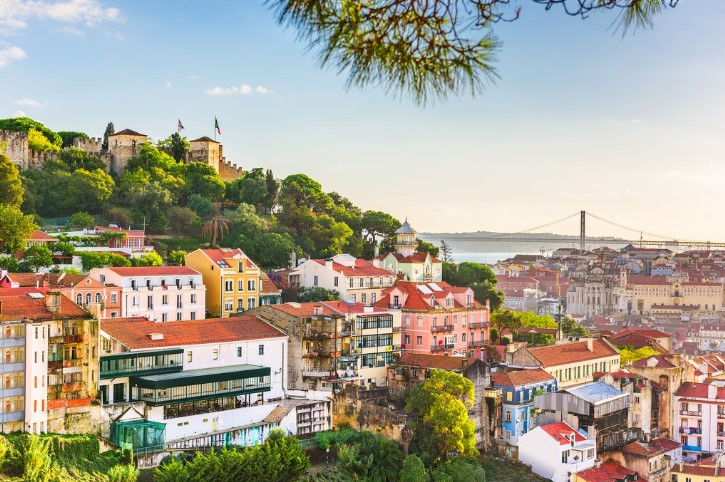 Built on seven hills, bathed by the River Tagus estuary, steeped in history and blessed by a sun-baked climate, Lisbon is truly one of the world’s most stunning cities. While its geography lends itself to nonstop picture postcard viewpoints, the vibrancy of the Portuguese capital and its endless places of interest has transformed it into a mecca for tourists.
Built on seven hills, bathed by the River Tagus estuary, steeped in history and blessed by a sun-baked climate, Lisbon is truly one of the world’s most stunning cities. While its geography lends itself to nonstop picture postcard viewpoints, the vibrancy of the Portuguese capital and its endless places of interest has transformed it into a mecca for tourists.
Whether travelling alone, as a couple, with friends or family, Lisbon has plenty to offer to leave a lasting impression on every visitor. Here are 10 fun things to do in Lisboa.
Walk over the Aqueduto das Águas Livres
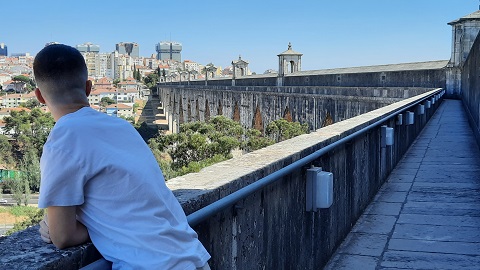 Built to address the scarcity of water for Lisbon’s growing population, most of this incredible feat of engineering was constructed in the first half of the 18th century, the structure so sound that it was practically undamaged by the devastating earthquake of 1755 that razed the majority of the city to the ground.
Built to address the scarcity of water for Lisbon’s growing population, most of this incredible feat of engineering was constructed in the first half of the 18th century, the structure so sound that it was practically undamaged by the devastating earthquake of 1755 that razed the majority of the city to the ground.
It was the setting for notorious serial killer Diogo Alves to perpetrate his crimes, robbing his victims then throwing them off the 65-metre-high structure to their death, simulating suicide. Alves was the last man in Portugal to be sentenced to death and was hanged in 1837.
Now free from lurking murderers, for a small fee (€4 at the time of writing, children free of charge) visitors can walk along the aqueduct across the Vale de Alcântara and back again on the other side, taking in scenic views of the Monsanto Forest, the 25 de Abril bridge, the River Tagus, the Jesus Christ statue and the cityscape.
Visit the castle
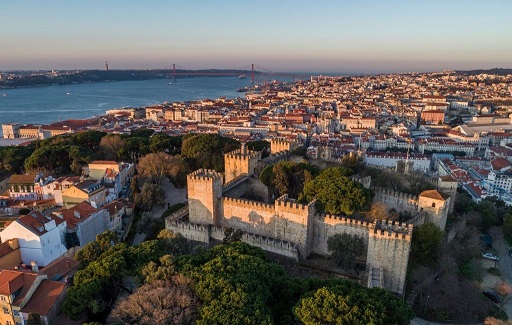 Strategically perched on a hilltop overlooking the heart of the city is the Castelo de São Jorge, the oldest parts of which date back to the 6th century. The castle was fortified and rebuilt successively by the Romans, Visigoths and Moors, and reconstructed several times after being largely destroyed in the 1755 earthquake.
Strategically perched on a hilltop overlooking the heart of the city is the Castelo de São Jorge, the oldest parts of which date back to the 6th century. The castle was fortified and rebuilt successively by the Romans, Visigoths and Moors, and reconstructed several times after being largely destroyed in the 1755 earthquake.
You can walk along the walls, peak through the battlements at the amazing views, stroll through the courtyards among peacocks, statues and rows of cannons, pause for refreshment at the café and breathe in 1500 years of history. Even when it gets busy, the spacious and varied layout lends Portugal’s most visited tourist attraction a relaxed and pleasant atmosphere.
The castle houses a permanent exhibition of artefacts from the Lisbon region dating back to the 8th century BC, while in the “Câmara Obscura” room a periscope system provides a real-time 360º vision of the city’s iconic sites.
But on top of learning about the castle and its history, one of the best features of a visit to Castelo de São Jorge is the breath-taking views at almost every turn. The city’s colourful architecture hugging the hillsides, the straw-coloured waters of the sun-kissed River Tagus and the deep blue sky is a juxtaposition to behold.
Go to the football
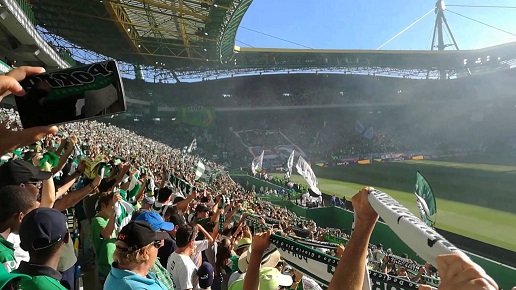 Lisbon is one of Europe’s most historical football cities. Home to two-time European champions Benfica and Sporting Clube de Portugal, the club that spawned Ballon D’Or winners Cristiano Ronaldo and Luís Figo, a visit to Benfica’s Estádio da Luz and Sporting’s José Alvalade stadiums is an absolute must for any right-minded football fan.
Lisbon is one of Europe’s most historical football cities. Home to two-time European champions Benfica and Sporting Clube de Portugal, the club that spawned Ballon D’Or winners Cristiano Ronaldo and Luís Figo, a visit to Benfica’s Estádio da Luz and Sporting’s José Alvalade stadiums is an absolute must for any right-minded football fan.
The two giants of Portuguese football play their league games on alternate weekends so you should be able to catch one or other during the August-May season. The ideal scenario, though, is to witness the Lisbon derby where all the passion of this football-adoring country and the fierce rivalry between the city rivals comes to boiling point to create an effervescent atmosphere crackling with tension and excitement.
But the feast of football on offer in the Portuguese capital does not stop there. Belenenses boasts arguably the most beautiful setting for a football stadium in Portugal, overlooking the 25 de Abril bridge spanning the River Tagus with the Jesus Christ statue in the background, and it is a club with a rich history as one of only two teams outside the traditional “Big Three” of FC Porto, Benfica and Sporting to win the Portuguese championship.
Atlético and Casa Pia are two other historical clubs located in Lisbon that often compete in the top national divisions, while a host of amateur clubs also play in the district leagues.
For serious soccer enthusiasts, follow the example of Steve Penny and a group of English football tourists and turn your vacation to the Portuguese capital into an odyssey around stadiums and clubs of varying size and importance in and around Lisbon, as described in colourful detail in Tarts, Trams and Tuk Tuks.
Eat a Pastel de Belém… or two or three or four
 Pasteis de Nata are a symbol of Portugal, the delicious custard tarts an irresistible treat at any time of the day or night and on sale all over the country. But the best specimens, made according to the original and secret recipe, are found at the Fábrica dos Pastéis de Belém café in the picturesque zone of Belém.
Pasteis de Nata are a symbol of Portugal, the delicious custard tarts an irresistible treat at any time of the day or night and on sale all over the country. But the best specimens, made according to the original and secret recipe, are found at the Fábrica dos Pastéis de Belém café in the picturesque zone of Belém.
Although business is ferocious all year round, the fact the tarts are cooked on a large scale in-house means the supply is never-ending and the queue moves quickly. Nevertheless, countless satisfied customers invariably leave with the same advice: “order double what you originally planned!” This wonderful indulgence is best enjoyed fresh out of the oven, still warm, with a sprinkling of cinnamon and sugar powder on top. Delectable.
Take in Lisbon’s sights and streets on the No. 28 tram
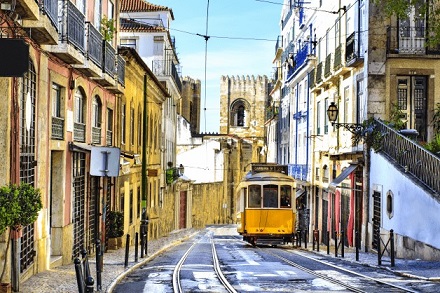 A trip on a Lisbon tram can be quite an experience. Cars, busses, bicycles, scooters, tuk-tuks and pedestrians all competing for the same road space can try the tram driver’s patience… But a window seat on one of these quaint blasts from the past provides a marvellous way to see Lisbon life as the bright yellow elétrico trundles along the winding and hilly streets of the city.
A trip on a Lisbon tram can be quite an experience. Cars, busses, bicycles, scooters, tuk-tuks and pedestrians all competing for the same road space can try the tram driver’s patience… But a window seat on one of these quaint blasts from the past provides a marvellous way to see Lisbon life as the bright yellow elétrico trundles along the winding and hilly streets of the city.
The No. 28 tram has the added bonus of passing by many of Lisbon’s top tourist neighbourhoods: Graça, Castelo, Alfama, Baixa, Chiado, Bairo Alto, São Bento and Estrela. This iconic tram ride will give you a good overview of the places you will want to visit or have already ticked off your list.
To best enjoy the ride take into account the following tips:
- Try to catch the tram at the start of the route at either end to get a window seat. It gets very busy along the way.
- For the same reason an early morning ride before the crowds are out in full force is advisable. The first tram sets off at 6.00 am.
- If you do not have a seat and have to stand, HOLD ON TIGHT! The brusque stop-starting and sudden bends can easily make you lose your balance.
- Beware of pick-pockets who are known to target tourists on this route.
A stroll in the park(s)
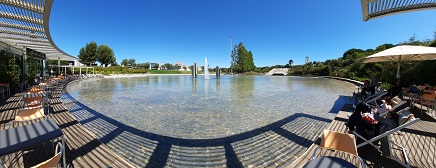 Amidst the cityscape comprising colourful architecture tumbling down every available slope, historical neighbourhoods of winding alleyways, glamorous shopping zones and broad avenues, Lisbon’s array of extremely pleasant parks and gardens is sometimes lost on the casual visitor.
Amidst the cityscape comprising colourful architecture tumbling down every available slope, historical neighbourhoods of winding alleyways, glamorous shopping zones and broad avenues, Lisbon’s array of extremely pleasant parks and gardens is sometimes lost on the casual visitor.
One of the prettiest is Gulbenkian Garden (pictured, below), especially recommended if you are seeking to cool off on a hot day. Densely wooded, it is dotted with ponds, lakes, ducks, lawns and shaded pathways and houses a Modern Art Center. The Eduardo VII Park is the biggest park in central Lisbon from where you can take in an amazing panoramic view of the Marquês de Pombal statue, Avenida da Liberdade, downtown Lisbon and the River Tagus yonder. Nearby is the beautiful Jardim Amália Rodrigues (pictured, above) containing a patio café around a lake of crystalline water.
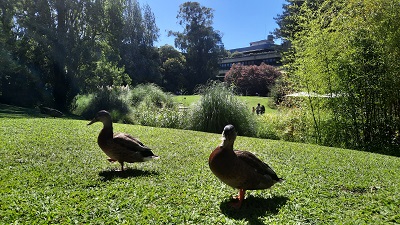 In front of the magnificent Estrela Basilica one finds the Jardim de Estrela, a historical park that combines a tropical garden with romanticism. Its numerous lawns are ideal for a picnic in the shade of enormous centuries-old trees. It also contains a children’s playground and is frequently the venue of a variety of bric-a-brac, organic food and handicraft fairs.
In front of the magnificent Estrela Basilica one finds the Jardim de Estrela, a historical park that combines a tropical garden with romanticism. Its numerous lawns are ideal for a picnic in the shade of enormous centuries-old trees. It also contains a children’s playground and is frequently the venue of a variety of bric-a-brac, organic food and handicraft fairs.
Torel Garden and the Botto Machado Garden are two other options, both strategically located to provide stunning views over the city.
Check out the Bairro Alto night life
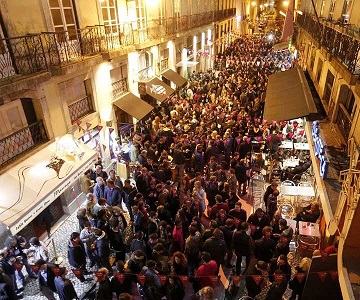 For a lively and fun night out you will struggle to find a better destination than Lisbon’s Bairro Alto anywhere in the world.
For a lively and fun night out you will struggle to find a better destination than Lisbon’s Bairro Alto anywhere in the world.
Throughout the network of narrow streets, this historical neighbourhood is brimming with bars, nightclubs, restaurants and trendy evening-opening shops. When night falls, a bohemian atmosphere permeated by laughter, chatter and chinking glasses extends into the wee small hours of the night. Most of the bars are small meaning the patrons spill out onto the street, drink in hand, with live music emanating from several of them only adding to the festive atmosphere.
For a more sedate but equally exhilarating experience, try one of the Fado houses where you can hear this famous Portuguese art form usually enacted by a single guitar player and a lone singer performing a repertoire of powerful and largely melancholy songs about longing for the past and unrequited love.
Go to Belém – history and culture
The picturesque and historical neighbourhood of Belém concentrates several of Lisbon’s most well-known landmarks. Dominating the zone is the magnificent Jerónimos Monastery, one of the finest examples of Portuguese Manueline architecture characterised by intricate, flamboyant stonework brimming with decorative carvings alluding to the great Portuguese navigational feats of the 15th and 16th centuries, intertwined with religious and botanical motifs and symbols. The cloisters of the monastery provide a perfect example of this aesthetically stunning stonework and the church contains the tomb of King Manuel I, after whom the style of architecture is named.
On the other side of the road to the monastery is Belém Cultural Centre (CCB), which initially provoked huge protests when it was built in the early 1990s given its contrasting modern design directly in front of the historical Jerónimos Monastery. However, over time people have recognised its importance as one of Lisbon’s foremost cultural facilities and the pleasant mellow colours of its brickwork and interesting design has made it a landmark in its own right. It hosts conferences, exhibitions and a wide range of performance arts and concerts. Click here to see what’s on via the official CCB website.
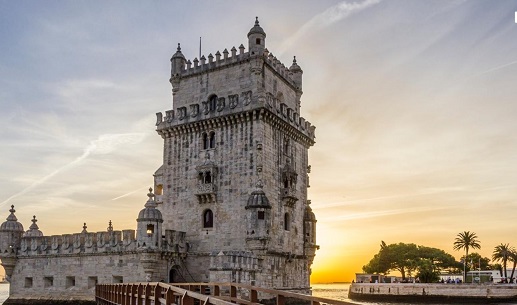 Also within walking distance through the pleasant gardens and parks around the Jerónimos Monastery and the CCB one finds the iconic Belém Tower (pictured, left) – another splendid example of the Manueline style of architecture – and the Monument to the Discoveries.
Also within walking distance through the pleasant gardens and parks around the Jerónimos Monastery and the CCB one finds the iconic Belém Tower (pictured, left) – another splendid example of the Manueline style of architecture – and the Monument to the Discoveries.
Nearby a trip to the former thermoelectric Power Station that now houses the Electricity Museum is highly recommended. The incredible boiler room contains humungous old high-pressure boilers, control panels, air and fuel circuits, precarious raised aisles and narrow channels that give a real feel for the difficult working conditions when the plant was in operation. It also includes a great section for kids (and adults) to conduct electrical experiments with a variety of educational devices.
The above suggestions by no means exhaust the places of interest to visit in Belém. Other options shall be discussed in future articles but as you can see, any visit to Lisbon must necessarily include at least one lengthy day trip to Belém, and not only to eat the world-famous Pastéis! (see no. 4)
Go to the beach
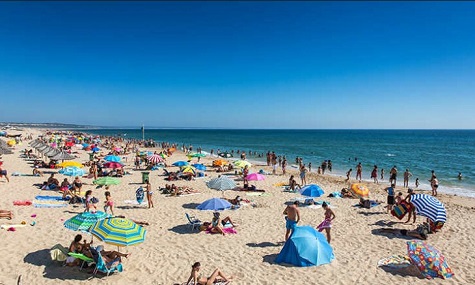 In addition to the numerous attractions and features of Portugal’s capital, another factor that makes Lisbon such a special city is the selection of wonderful beaches right on its doorstep, an especially welcome diversion for holidaymakers travelling with children who may need a break from cultural/sightseeing activities.
In addition to the numerous attractions and features of Portugal’s capital, another factor that makes Lisbon such a special city is the selection of wonderful beaches right on its doorstep, an especially welcome diversion for holidaymakers travelling with children who may need a break from cultural/sightseeing activities.
Catch the train at the Cais do Sodré station and a short trip along the coast will take you to a selection of enticing beaches. Carcavelos is the largest and is the best choice for body-borders and surfers. At the end of the line we get to Cascais, which contains a natural ocean pool and a trip here can be combined with an evening meal and a stroll around the charming seaside town.
Alternatively, a bus ride over the River Tagus takes you to the Costa da Caparica coastline, a 15-km stretch of beaches backed by sand-dunes providing a vivid visual contrast to the deep blue of the vastness of the Atlantic Ocean (pictured, above). The further south you go the less crowded it becomes. There are also specific nudist and gay beaches near Fonte da Telha. In the summer months a train operates stopping off at the different beaches.
Sample the culinary delights where bacalhau is king
As in any modern city, Lisbon is well furnished with restaurants offering food from every continent, but it would be remiss to visit Portugal and not sample the magnificent local cuisine. The national dish, “bacalhau” (dried cod), is said to have 365 recipes – one for every day of the year.
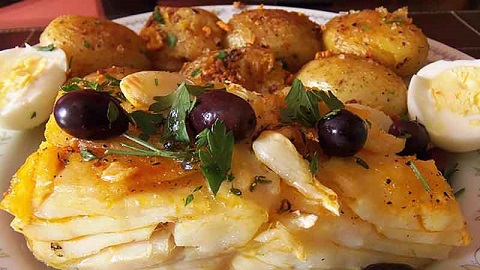 Bacalhau à Brás (shredded cod with onion, thinly chopped fried potatoes and eggs) and the classic Bacalhau Assado na Brasa (Barbecued Cod) and Bacalhau Assado no Forno (oven-baked bacalhau), seasoned with olive oil, garlic and onions and served with baked potatoes are options that will give you an authentic local dining experience, and of course should be accompanied by a fine Portuguese wine.
Bacalhau à Brás (shredded cod with onion, thinly chopped fried potatoes and eggs) and the classic Bacalhau Assado na Brasa (Barbecued Cod) and Bacalhau Assado no Forno (oven-baked bacalhau), seasoned with olive oil, garlic and onions and served with baked potatoes are options that will give you an authentic local dining experience, and of course should be accompanied by a fine Portuguese wine.
Cozido à Portuguesa is another typical dish comprising a generously served mix of boiled meats and vegetables, which is especially recommended for those with a voracious appetite!
The above suggestions are somewhat rudimentary (no less delicious for that), but of course Lisbon restaurants serve a multitude of more sophisticated offerings with their menus typically listing a wide range of octopus, shellfish, seafood and fish dishes and the full spectrum of meat options, the sumptuously succulent Mirandela steak a big favourite.
Finish off with a typical conventual sweet, which as the name alludes to are desserts originally contrived by nuns who lived in Portuguese convents and monasteries. These vary hugely although eggs, almonds and copious amounts of sugar are a common thread underpinning most of them, the scrumptious Tarte de Amêndoa a prime example. For a healthier option, the fruit of the season is always splendidly presented, with a generously served slice of fresh melon a highlight in the summer months.
by Tom Kundert







